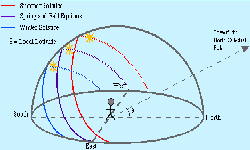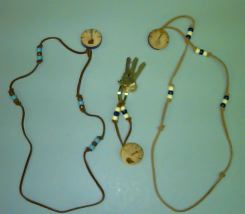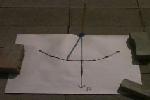 To understand how a horizontal sundial tells time, we
must
first understand the path the Sun takes
through the sky.
To understand how a horizontal sundial tells time, we
must
first understand the path the Sun takes
through the sky. In the text below you will find the following links.
In the text below you will find the following links.
 To understand how a horizontal sundial tells time, we
must
first understand the path the Sun takes
through the sky.
To understand how a horizontal sundial tells time, we
must
first understand the path the Sun takes
through the sky.
Once you understand the motion of the Sun across the sky for the different seasons we need to recognize what feature of that motion is most useful for building a sundial.

To use your sundial you
will need to be able to find the direction of due south. A shadowplot is a fun and easy way to find geographic
south.
In addition to finding the direction of south you will
need to know the latitude of the town or city
where you intend to use your sundial in order to build it accurately.
If you do not know the latitude of a particular part of the world you can
figure it out by looking on a globe or a map that has the latitude lines
marked. Latitude is measured in degrees from the equator. The equator is
zero degrees latitude, the north and south poles are ninety degrees
latitude. Click here to view a latitude
grid of the world.
Now that we understand a little about how the Sun moves through the sky, we know how to find due south and we know the latitude for which we want to build a sundial, we are ready to continue.
![]()
 The complete construction of a sundial involves the use
of a protractor and
the understanding of some trigonometric functions like sine and tangent.
The complete construction of a sundial involves the use
of a protractor and
the understanding of some trigonometric functions like sine and tangent.
The different levels below allow you to construct a sundial no matter what experience you have with these mathematical tools. Select the level appropriate for your understanding from the choices below and we'll get to work!
![]()
ADVANCED
If you are comfortable using a protractor and are familiar with the trig
functions sine and tangent this is the level for you!
INTERMEDIATE
If you are comfortable using a protractor to measure angles, but are not
familiar with the trig functions sine and tangent select this level.
NOVICE
If you are not comfortable using a protractor and are not familiar with
the trig functions sine and tangent start at this level.
***ACCURACY***
To compare the time on the sundial you construct to
the time on a clock, there are several adjustments which should be made.
The North American Sundial Society has a nice page which discusses these
adjustments. Visit: Sundial
Time vs. Clock Time .
****REMEMBER****
During daylight savings time you will need to add one hour to the
time on your sundial in order to agree with local "clock" time.
![]()

![]()
Lesson designed by the YPOP Team
For questions about this lesson, please contact
Michelle B. Larson